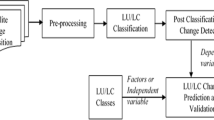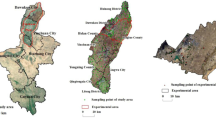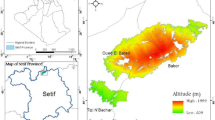Abstract
Drought, as a recurring extreme climate event, affects the structure, function, and process of terrestrial ecosystems. Despite the increasing occurrence and intensity of the drought in the past decade in Southwestern China, the impacts of continuous drought events on vegetation in this region remain unclear. During 2001–2012, Southwestern China experienced the severe drought events from 2009 to 2011. Our aim is to characterize drought conditions in the Southwestern China and explore the impacts on the vegetation condition and terrestrial ecosystem productivity. The Standardized Precipitation Index (SPI) was used to characterize drought area and intensity and a light-use efficiency model was used to explore the effect of drought on the terrestrial ecosystem productivity with Moderate Resolution Imaging Spectrometer (MODIS) data. The SPI captured the major drought events in Southwestern China during the study period, indicated that the 12-year period of this study included both ‘normal’ precipitation years and two severe drought events in 2009–2010 and 2011. Results showed that vegetation greenness (Normalized Difference Vegetation Index, NDVI and Enhanced Vegetation Index, EVI) both declined in 2009/2010 drought, but the 2011 drought resulted in less declines of vegetation greenness and productivity due to shorten drought duration and rising temperature. Meanwhile, it was about 5 months lapse between drought events and maximum declines in vegetation greenness for 2009/2010 drought events. In addition, forest, grassland and cropland revealed significant different ecosystem responses to drought. It indicated that grassland showed an early sensitivity to drought, while cropland was the most sensitive to water deficit and forest was more resilient to drought. This study suggests that it is necessary to detect the difference responses of ecosystem to drought in a regional area with satellite data and ecosystem model.
Similar content being viewed by others
References
Anderson L O, Malhi Y, Aragão L E O C et al., 2010. Remote sensing detection of droughts in Amazonian forest canopies. New Phytologist, 187(3): 733–750. doi: 10.1111/j.1469-8137. 2010.03355.x.
Brando P M, Goetz S J, Baccini A et al., 2010. Seasonal and interannual variability of climate and vegetation indices across the Amazon. Proceedings of the National Academy of Sciences of the United States of America, 107(33): 14685–14690. doi: 10.1073/pnas.0908741107
Bréda N, Huc R, Granier A et al., 2006. Temperate forest trees and stands under severe drought: a review of ecophysiological responses, adaptation processes and long-term consequences. Annals of Forest Science, 63(6): 625–644. doi: 10.1051/forest: 2006042
Chen G S, Tian H Q, Zhang C et al., 2012. Drought in the Southern United States over the 20th century: variability and its impacts on terrestrial ecosystem productivity and carbon storage. Climatic Change, 114(2): 379–397. doi: 10.1007/s10584-012-0410-z
Ciais P, Reichstein M, Viovy N et al., 2005. Europe-wide reduction in primary productivity caused by the heat and drought in 2003. Nature, 437 (7058): 529–533. doi: 10.1038/nature03972
Cook E R, Woodhouse C A, Eakin C M et al., 2004. Long-term aridity changes in the western United States. Science, 306 (5698): 1015–1018. doi: 10.1126/science.1102586
Dai A G, 2011. Drought under global warming: a review. Wiley Interdisciplinary Reviews-Climate Change, 2(1): 45–65. doi: 10.1002/wcc.81
Fernández M E, Gyenge J E, Varela S et al., 2014. Effects of the time of drought occurrence within the growing season on growth and survival of Pinus ponderosa seedlings. Trees, 28 (3): 745–756. doi: 10.1007/s00468-014-0986-1
Gao H, Yang S, 2009. A severe drought event in northern China in winter 2008–2009 and the possible influences of La Nina and Tibetan Plateau. Journal of Geophysical Research-Atmospheres, 114 (D24): D24104. doi: 10.1029/2009JD012430
Gu Y X, Hunt E, Wardlow B et al., 2008. Evaluation of MODIS NDVI and NDWI for vegetation drought monitoring using Oklahoma Mesonet soil moisture data. Geophysical Research Letters, 35(22): L22401. doi: 10.1029/2008GL035772
Huete A, Didan K, Miura T et al., 2002. Overview of the radiometric and biophysical performance of the MODIS vegetation indices. Remote Sensing Environment, 83(1–2): 195–213.
Huete A, Didan K, Shimabukuro Y E et al., 2006. Amazon rainforests green-up with sunlight in dry season. Geophysical Research Letters, 33(6): L06405. doi: 10.1029/2005GL025583
Hutchinson M F, 2001. ANUSPLIN User Guide. Canberra: Australian National University, Canberra.
Ji L, Peters A J, 2003. Assessing vegetation response to drought in the northern Great Plains using vegetation and drought indices. Remote Sensing of Environment, 87(1): 85–98. doi: 10.1016/S0034-4257(03)00174-3
Klos R J, Wang G G, Bauerle W L et al., 2009. Drought impact on forest growth and mortality in the southeast USA: an analysis using Forest Health and Monitoring data. Ecological Applications, 19(3): 699–708. doi: 10.1890/08-0330.1
Knapp A K, Fay P A, Blair J M et al., 2002. Rainfall variability, carbon cycling, and plant species diversity in a mesic grassland. Science, 298(5601): 2202–2205. doi: 10.1126/science.1076347
Loarie S R, Duffy P B, Hamilton H et al., 2009. The velocity of climate change. Nature, 462(7276): 1052–1055. doi: 10.1038/nature08649
Luo Tianxiang, 1996. Patterns of Net Primary Productivity for Chinese Major Forest Types and Their Mathematical Models. Beijing: Committee of Synthesis Investigation of Natural Resources, Chinese Academy of Sciences, 211. (in Chinese)
McKee T B, Doesken N J, Kleist J, 1993. The relationship of drought frequency and duration to time scales. Eighth Conference on Applied Climatology. Anaheim CA, USA: American Meteorological Society, 179–186.
Meir P, Metcalfe D B, Costa A C L et al., 2008. The fate of assimilated carbon during drought: impacts on respiration in Amazon rainforests. Philosophical Transactions of the Royal Society B-Biological Sciences, 363(1498): 1849–1855. doi: 10.1098/rstb.2007.0021
Mohammat A, Wang X H, Xu X T et al., 2013. Drought and spring cooling induced recent decrease in vegetation growth in Inner Asia. Agricultural and Forest Meteorology, 178–179: 21–30. doi: 10.1016/j.agrformet.2012.09.014
Mu Q Z, Zhao M S, Kimball J S et al., 2013. A Remotely Sensed Global Terrestrial Drought Severity Index. Bulletin of the American Meteorological Society, 94(1): 83–98. doi: 10.1175/BAMS-D-11-00213.1.
Mueller B, Seneviratne S I, 2012. Hot days induced by precipitation deficits at the global scale. Proceedings of the National Academy of Sciences of the United States of America, 109(31): 12398–12403. doi: 10.1073/pnas.1204330109
Nemani R R, Keeling C D, Hashimoto H et al., 2003. Climate-driven increases in global terrestrial net primary production from 1982 to 1999. Science, 300(5625): 1560–1563. doi: 10.1126/science.1082750
Ni J, Zhang X S, Scurlock J M O, 2001. Synthesis and analysis of biomass and net primary productivity in Chinese forests. Annals of Forest Science, 58(4): 351–384. doi: 10.1051/forest: 2001131
Peng C H, Ma Z H, Lei X D et al., 2011. A drought-induced pervasive increase in tree mortality across Canada’s boreal forests. Nature Climate Change, 1(9): 467–471. doi: 10.1038/nclimate1293
Phillips O L, Aragão L E O C, Lewis S L et al., 2009. Drought Sensitivity of the Amazon Rainforest. Science, 323(5919): 1344–1347. doi: 10.1126/science.1164033
Phillips O L, van der Heijden G, Lewis S L et al., 2010. Drought-mortality relationships for tropical forests. New Phytologist, 187(3): 631–646. doi: 10.1111/j.1469-8137.2010.03359.x
Potter C, Klooster S, Myneni R et al., 2003. Continental-scale comparisons of terrestrial carbon sinks estimated from satellite data and ecosystem modeling 1982–1998. Global and Planetary Change, 39(3–4): 201–213. doi: 10.1016/j.gloplacha.2003.07.001
Potter C, Klooster S, Hiatt C et al., 2011. Changes in the carbon cycle of Amazon ecosystems during the 2010 drought. Environmental Research Letters, 6(3): 034024. doi: 10.1088/1748-9326/6/3/034024
Potter C S, Randerson J T, Field C B et al., 1993. Terrestrial ecosystem production: a process model-based on global satellite and surface data. Global Biogeochemical Cycles, 7(4): 811–841. doi: 10.1029/93GB02725
Potter C S, Klooster S, Brooks V, 1999. Interannual variability in terrestrial net primary production: exploration of trends and controls on regional to global scales. Ecosystems, 2(1): 36–48. doi: 10.1007/s100219900056
Qiu J, 2010. China drought highlights future climate threats. Nature, 465(7295): 142–143. doi: 10.1038/465142a
Qu X, Huang G, Zhou W, 2014. Consistent responses of East Asian summer mean rainfall to global warming in CMIP5 simulations. Theoretical and Applied Climatology, 117(1–2): 123–131. doi: 10.1007/s00704-013-0995-9
Reichstein M, Ciais P, Papale D et al., 2007. Reduction of ecosystem productivity and respiration during the European summer 2003 climate anomaly: a joint flux tower, remote sensing and modelling analysis. Global Change Biology, 13(3): 634–651. doi: 10.1111/j.1365-2486.2006.01224.x
Saatchi S, Asefi-Najafabady S, Malhi Y et al., 2013. Persistent effects of a severe drought on Amazonian forest canopy. Proceedings of the National Academy of Sciences of the United States of America, 110(2): 565–570. doi: 10.1073/pnas.1204651110
Saleska S R, Didan K, Huete A R et al., 2007. Amazon forests green-up during 2005 drought. Science, 318(5850): 612. doi: 10.1126/science.1146663
Salinas-Zavala C A, Douglas A V, Diaz H F, 2002. Interannual variability of NDVI in northwest Mexico. Associated climatic mechanisms and ecological implications. Remote Sensing of Environment, 82(2–3): 417–430. doi: 10.1016/S0034-4257(02)00057-3
Samanta A, Ganguly S, Hashimoto H et al., 2010. Amazon forests did not green-up during the 2005 drought. Geophysical Research Letters, 37(5): L05401. doi: 10.1029/2009GL042154
Schwinning S, Starr B I, Ehleringer J R, 2005. Summer and winter drought in a cold desert ecosystem (Colorado Plateau) part II: effects on plant carbon assimilation and growth. Journal of Arid Environment, 61(1): 61–78. doi: 10.1016/j.jaridenv.2004.07.013
Tanja S, Berninger F, Vesala T et al., 2003. Air temperature triggers the recovery of evergreen boreal forest photosynthesis in spring. Global Change Biology, 9(10): 1410–1426. doi: 10.1046/j.1365-2486.2003.00597.x
Teuling A J, Seneviratne S I, Stockli R et al., 2010 Contrasting response of European forest and grassland energy exchange to heatwaves. Nature Geoscience, 3(10): 722–727. doi: 10.1038/ngeo950
van Oijen M, Beer C, Cramer W et al., 2013. A novel probabilistic risk analysis to determine the vulnerability of ecosystems to extreme climatic events. Environmental Research Letters, 8(1): 015032. doi: 10.1088/1748-9326/8/1/015032
Wagle P, Xiao X, Suyker A, 2015. Estimation and analysis of gross primary production of soybean under various management practices and drought conditions. ISPRS Journal of Photogrammetry and Remote Sensing, 99: 70–83
Wang J, Rich P M, Price K P, 2003. Temporal responses of NDVI to precipitation and temperature in the central Great Plains, USA. International Journal of Remote Sensing, 24(11): 2345–2364. doi: 10.1080/01431160210154812
Wang Lin, Chen Wen, Zhou Wen, 2014. Assessment of Future Drought in Southwest China Based on CMIP5 Multimodel Projections. Advances in Atmospheric Sciences, 31(5): 1035–1050. doi: 10.1007/s00376-014-3223-3
Wen X F, Wang H M, Wang J L et al., 2010. Ecosystem carbon exchanges of a subtropical evergreen coniferous plantation subjected to seasonal drought, 2003–2007. Biogeosciences, 7(1): 357–369. doi: 10.5194/bg-7-357-2010
Wu Z Y, Lu G H, Wen L et al., 2011. Reconstructing and analyzing China’s fifty-nine year (1951–2009) drought history using hydrological model simulation. Hydrology and Earth System Sciences, 15(9): 2881–2894. doi: 10.5194/hess-15-2881-2011
Xiao X M, Zhang Q Y, Braswell B et al., 2004. Modeling gross primary production of temperate deciduous broadleaf forest using satellite images and climate data. Remote Sensing of Environment, 91(2): 256–270. doi: 10.1016/j.rse.2004.03.010
Xu L A, Samanta A, Costa M H et al., 2011. Widespread decline in greenness of Amazonian vegetation due to the 2010 drought. Geophysical Research Letters, 38(7): L07402. doi: 10.1029/2011GL046824
Xu X T, Piao S L, Wang X H et al., 2012. Spatio-temporal patterns of the area experiencing negative vegetation growth anomalies in China over the last three decades. Environmental Research Letters, 7(3): 035701. doi: 10.1088/1748-9326/7/3/035701
Yang J, Gong D Y, Wang W S et al., 2012. Extreme drought event of 2009/2010 over southwestern China. Meteorology and Atmospheric Physics, 115(3–4): 173–184. doi: 10.1007/s00703-011-0172-6
Zeng N, Qian H F, Roedenbeck C et al., 2005. Impact of 1998–2002 midlatitude drought and warming on terrestrial ecosystem and the global carbon cycle. Geophysical Research Letters, 32(22): L22709. doi: 10.1029/2005GL024607
Zhang L, Xiao J F, Li J et al., 2012. The 2010 spring drought reduced primary productivity in southwestern China. Environmental Research Letters, 7(4): 045706. doi: 10.1088/1748-9326/7/4/045706
Zhang W J, Wang H M, Yang F T et al., 2011. Underestimated effects of low temperature during early growing season on carbon sequestration of a subtropical coniferous plantation. Biogeosciences, 8(6): 1667–1678. doi: 10.5194/bg-8-1667-2011
Zhao M S, Heinsch F A, Nemani R R et al., 2005. Improvements of the MODIS terrestrial gross and net primary production global dataset. Remote Sensing of Environment, 95(2): 164–176. doi: 10.1016/j.rse.2004.12.011
Zhao M S, Running S W, 2010. Drought-Induced Reduction in Global Terrestrial Net Primary Production from 2000 through 2009. Science, 329(5994): 940–943. doi: 10.1126/science.1192666
Zhou J, Zhang Z Q, Sun G et al., 2013. Response of ecosystem carbon fluxes to drought events in a poplar plantation in Northern China. Forest Ecology and Management, 300: 33–42. doi: 10.1016/j.foreco.2013.01.007
Zhu W Q, Pan Y Z, He H et al., 2006. Simulation of maximum light use efficiency for some typical vegetation types in China, Chinese Science Bulletin, 51(4): 457–463. doi: 10.1007/s11434-006-0457-1
Acknowledgements
We would like to acknowledge Wenge NI-MEISTER of Hunter College of The City University of New York for help with revising this manuscript.
Author information
Authors and Affiliations
Corresponding author
Additional information
Foundation item: Under the auspices of National Key Research and Development Program of China (No. 2016YFB0501501, 2017YFB0504000), National Natural Science Foundation of China (No. 41401110, 31400393)
Rights and permissions
About this article
Cite this article
Zhou, L., Wang, S., Chi, Y. et al. Drought Impacts on Vegetation Indices and Productivity of Terrestrial Ecosystems in Southwestern China During 2001–2012. Chin. Geogr. Sci. 28, 784–796 (2018). https://doi.org/10.1007/s11769-018-0967-1
Received:
Accepted:
Published:
Issue Date:
DOI: https://doi.org/10.1007/s11769-018-0967-1




